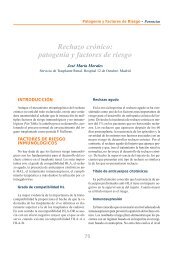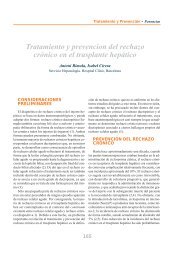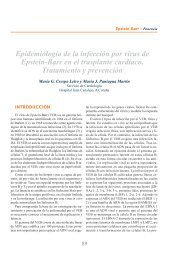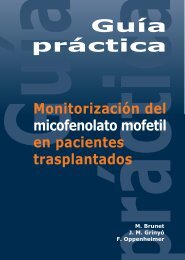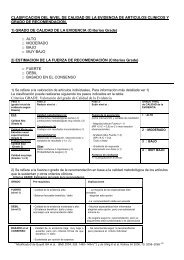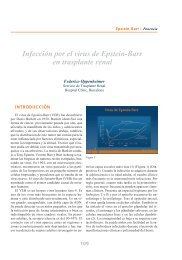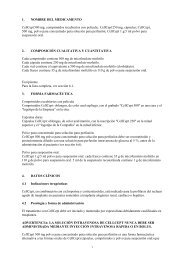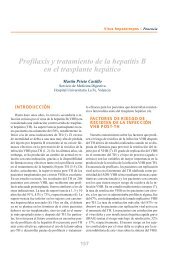Untitled - Roche Trasplantes
Untitled - Roche Trasplantes
Untitled - Roche Trasplantes
Create successful ePaper yourself
Turn your PDF publications into a flip-book with our unique Google optimized e-Paper software.
PROTOCOL BIOPSIES AND THE DIAGNOSIS OF HUMORAL REJECTION<br />
• Clinical evidence of acute allograft dysfunction.<br />
• Histological evidence of acute allograft injury, i.e. neutrophils, macrophages, or thrombi<br />
in capillaries (peritubular and/or glomerular capillaries), fibrinoid necrosis of arterioles,<br />
acute tubular injury.<br />
• Immunological evidence for the action of antibodies, i.e., C4d deposition in peritubular<br />
capillaries, or antibodies or C3 in arteries.<br />
• Serological evidence of donor-specific-antibodies at the time of biopsy.<br />
At least three of the four criteria should be given to make the diagnosis of acute humoral<br />
rejection. In this setting the biopsy has a central role since it can provide two (specific<br />
pathology and C4d) of the four diagnostic criteria. In this setting diagnostic pioneer work<br />
was done by Feucht and colleagues already in the early nineties. This group was the<br />
first to describe C4d as an in situ marker of acute antibody-mediated rejection in renal<br />
allografts showing a highly significant correlation to the presence of donor-specific<br />
antibodies in the patient’s serum. However, it took more than a decade to finally implement<br />
the entity of AHR, although the characteristic morphological changes of antibodymediated<br />
allograft injury were well described by several groups, mostly from cases of<br />
hyperacute rejection in pre-sensitized patients with high titers of preformed antibodies.<br />
These pathological features comprise capillary congestion with neutrophils and/or<br />
macrophages (=capillaritis), glomerulitis, microthrombi, fibrinoid arterial necrosis, and<br />
acute tubular necrosis. Rarely all features are present simultaneously. From our experiences<br />
the most frequent morphological findings in C4d positive biopsies are acute tubular<br />
injury and capillaritis (Figure 1), followed by glomerulitis (Figure 2), whereas microthrombi<br />
and fibrinoid arterial necrosis are very rare nowadays.<br />
The up-date of the Banff classification recommends a C4d stain to be obligatory for all<br />
renal allograft biopsies. However, the consecutively published incidence of C4d detection<br />
in renal allograft biopsies by immunohistochemistry and immunofluorescence<br />
varies between 21-51% in various transplant centers. Herewith the incidence is higher<br />
in biopsies with simultaneous signs of acute cellular rejection than in those without.<br />
A retrospective multicenter study conducted in three European transplants centers<br />
revealed that differences in the percentage of pre-sensitized, mostly re-transplanted<br />
patients is one explanation for a variable incidence of C4d detection. Furthermore,<br />
up to date no internationally accepted cut-off levels to call a case C4d positive by immunohistochemistry<br />
or immunofluorescence are established, and therefore, methodological<br />
issues might explain for different incidences in C4d-positive cases as well. In<br />
contrast, criteria defining the specificity of a C4d stain as a marker of AHR are exactly<br />
defined by the Banff community for frozen as well as paraffin-embedded tissue sections:<br />
53




